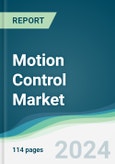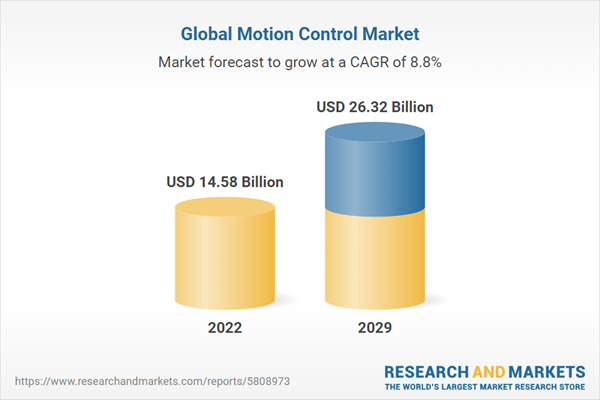The motion control market is anticipated to experience a CAGR of 8.80% throughout the forecast period, reaching a market size of US$26.319 billion by 2029, representing a substantial increase from US$14.583 billion recorded in 2022.
One of the primary reasons for the growth of motion control devices is the increasing penetration of the Industrial Internet of Things (IIoT) coupled with the rising number of smart factories. All these factors are expected to fuel the motion control market in the projected period. The industrial IoT has further increased the need and demand for well-connected machines in the industry. These connected machines alone cannot establish a pure digital transformation. Hence, to develop a seamless ecosystem among the machines and humans and to enhance the performance and end-to-end process, these motion controls are anticipated to come in handy, and their demand is expected to grow in the coming years.Increasing use of motion control in various end-user industries propels the market.
The rising use of motion control in end-user industries such as oil and gas and automotive is expected to provide fuel to the market in the projected period. The automotive sector is expected to hold a significant share of the market as motion control plays a vital role in fully automated and self-driving cars. The plug-and-play system consists of software that is integrated into an electronic control unit and helps the vehicle to have both transverse and lateral vehicle movement. Along with this, mechatronics and mechanical parts such as steering, dampers, brakes, and various control unit software include motion control, which is further expected to boost the market in the forecast period.Furthermore, various governments are launching programs that can help their country boost its electronic and smart device production. For instance, in May 2023, the Information Technology Industry Development Agency - Egypt (ITIDA), launched a program called “Electronics Innovation Empowerment Design Companies Enablement”. This is a program that will boost the country’s electronics sector under the Egypt Makes Electronics (EME) initiative. Such programs are expected to attract companies to design and develop their products such as circuits and systems in the Electronic Creativity Centre Knowledge City. These programs are expected to boost the growth of smart devices, contributing to motion control market growth. Tesla is one of the pioneer companies to launch auto-driven or self-driven cars. The company has been producing fully self-drives cars, that need a level 2 driver-assistance system. Many new and innovative automobiles are launched by the company that makes use of various technology. According to the company’s annual report, the automotive sales by Tesla, in 2020 were 24,604 million dollars, which almost doubled in 2021, and reached 44,125 million dollars, and in 2022, the company's revenue from automotive sales was 67,210 million dollars. With such increasing sales of new technology automobiles, which use motion controls for smooth functioning are expected to boost the market for motion controls in the projected period.
It is projected that the cooker market in North America will grow steadily.
The United States motion control market is expanding due to several important factors. The widespread use of robots and automation in many industries, particularly manufacturing, is a major driver of the need for accurate motion control systems. The concepts of Industry 4.0, which prioritize automation and digital integration, also support the market's expansion. Motion control solutions are increasingly needed to optimize production processes as a result of the comeback of the American manufacturing industry, which is bolstered by factors such as reshoring and modern manufacturing technology. The integration of artificial intelligence (AI) and robotics in the motion control industry in the United States fosters automation and aligns with Industry 4.0 concepts by improving precision and efficiency through improved control algorithms. Increased productivity and motion process optimization in a variety of sectors are facilitated by this connection. In alignment with the Industry 4.0 initiatives by the United States Government, the framework for Cyber-Physical Systems: Volume 1, NIST Special Publication 1500-201 was published. It states that "cyber-physical systems are smart systems that include engineered interacting networks of physical and computational components." Cobots, or robots that interact physically with humans in a shared office, are being used by manufacturers at a rapid rate.Compared to other cutting-edge technologies, the automation of labour-intensive jobs is a more prevalent reason for businesses to embrace AI and robotics. As per the Census Bureau of the United States, the adoption of AI and Robotics to automate processes was 54% and 66% respectively in the year 2022. Furthermore, the growth of the American manufacturing sector has had a positive effect on the motion control industry because it increases the need for precise automation, which in turn boosts the usage of motion control systems. As production facilities expand and modernize, the need for advanced motion control systems is anticipated to grow. These technologies allow for enhanced operational optimization, more efficiency, and better manufacturing processes. As per the NIST, the manufacturing industry in the United States, makes $2.3 trillion, or 11.4% of the whole U.S. Manufacturing's value contribution, both direct and indirect (i.e., purchases from other industries), was projected to have contributed 24% of the GDP. According to NIST's Manufacturing Cost Guide, manufacturing accounted for 76.6% of the overall environmental impact in the United States.
Additionally, motion control systems are evolving due to ongoing technical improvements such as better algorithms and advanced sensors. The growth of e-commerce propels the use of motion control in material handling systems, which reinforces the market's positive growth.
Market Key Developments
- January 2022, Moen launched a smart faucet with best-in-class motion control technology for a completely touchless operation. This new touchless technology will help the user to control temperature and water flow using simple hand motions.
Segmentation:
By Component:
- AC Drives
- Actuators
- Motion Controller
- Electronic Drives
- Others
By Application:
- Packaging
- Assembly/Disassembly
- Material Handling
- Metal Fabrication
- Others
By Industry vertical
- Automotive
- Aerospace, and Defense
- Electronics
- Packaging
- Manufacturing
- Others
By Geography
- North America
- USA
- Canada
- Mexico
- South America
- Brazil
- Argentina
- Others
- Europe
- United Kingdom
- Germany
- France
- Spain
- Others
- Middle East and Africa
- Saudi Arabia
- UAE
- Others
- Asia Pacific
- Japan
- China
- India
- South Korea
- Indonesia
- Thailand
- Others
Table of Contents
1. INTRODUCTION
2. RESEARCH METHODOLOGY
3. EXECUTIVE SUMMARY
4. MARKET DYNAMICS
5. MOTION CONTROL MARKET BY COMPONENT
6. MOTION CONTROL MARKET BY APPLICATION
7. MOTION CONTROL MARKET BY INDUSTRY VERTICAL
8. MOTION CONTROL MARKET BY GEOGRAPHY
9. COMPETITIVE ENVIRONMENT AND ANALYSIS
10. COMPANY PROFILES
Companies Mentioned
- ABB Ltd.
- FANUC Corporation
- Parker Hannifin Corporation
- Rockwell Automation, Inc.
- Siemens AG
- Yaskawa Electric Corporation
- Mitsubishi Electric Corporation
- Robert Bosch GmbH
- Altra Industrial Motion Corp.
- Novanta Inc.
Methodology

LOADING...
Table Information
| Report Attribute | Details |
|---|---|
| No. of Pages | 114 |
| Published | February 2024 |
| Forecast Period | 2022 - 2029 |
| Estimated Market Value ( USD | $ 14.58 Billion |
| Forecasted Market Value ( USD | $ 26.32 Billion |
| Compound Annual Growth Rate | 8.8% |
| Regions Covered | Global |
| No. of Companies Mentioned | 10 |









